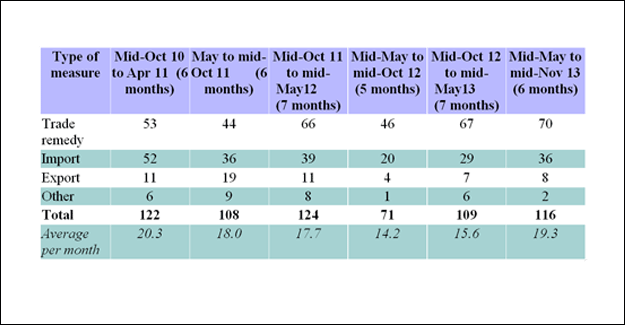
WTO: Trade restrictive measures increase as trade flows slow down
A WTO report on G-20 trade measures (mid-May 2013 to mid-November 2013) states that global economic slowdown hampered trade flows, even as trade restrictive measures increased during 2013.
World trade growth in 2013 is slower than expected
Global economic growth remains slow and uneven, not only in most developed economies but also in major emerging markets. The shortfall in activity has weighed heavily on world trade flows. Trade growth in 2013 registered only a slight increase over 2012. The volume of world merchandise trade is expected to grow by 2.5% in 2013 and 4.5% in 2014.
The number of new trade restrictions has increased
In the last six months, most G-20 members have put in place new trade restrictions. As many as 116 new trade restrictive measures were identified since the last WTO report, up from 109 measures recorded for the previous seven-month period. These were mainly new trade remedy actions, in particular the initiation of anti-dumping investigations, tariff increases and more stringent customs procedures. New measures affect around 1.1% of G-20 merchandise imports, equivalent to 0.9% of world merchandise imports.
The trade restrictive or distorting effects of behind-the-border measures, such as subsidies, public procurement activity and goods and services regulations, are more difficult to measure. The report raises the key question - whether these measures are being used deliberately to restrict or distort access to domestic markets. In the case of new TBT and SPS regulations, where data is more available, 2-3% of the thousands that are notified each year to the WTO are taken up by Members for closer scrutiny on the grounds that they raise specific trade concerns, and that proportion has not significantly changed over the past six years. Better transparency and more evidence are needed to evaluate properly the trade impact of behind-the-border measures.
Fewer trade liberalising or facilitating measures were taken than in the past
Some G-20 members also took measures that facilitate trade, although fewer than in the period covered by the last report. Around 33% of the total recorded measures can be considered as trade facilitating, compared with 40% at the time of the previous trade monitoring report. Facilitating measures are mainly in the form of termination of trade remedy actions and tariff reductions. These measures cover around 0.8% of G-20 merchandise imports and 0.6% of world imports.
Trade restrictions continue to accumulate
The accumulation of trade restrictions continues. This is a result of more new measures being taken during the most recent period. This time the rate of removal of restrictions put in place since the outbreak of the global crisis is slightly higher than in the previous period. Around 20% of the total number of trade-restrictive measures taken since October 2008 has so far been eliminated; this compares with 19% at the time of the previous report in June 2013.
All import-restrictive measures adopted since October 2008, excluding those that have been reported as terminated up to mid-November 2013, are estimated to cover around 3.9% of world merchandised imports, and around 5% of G-20 imports
Textile Excellence
If you wish to Subscribe to Textile Excellence Print Edition, kindly fill in the below form and we shall get back to you with details.








